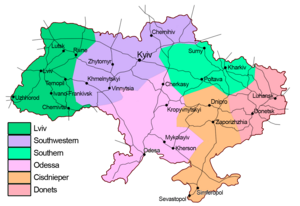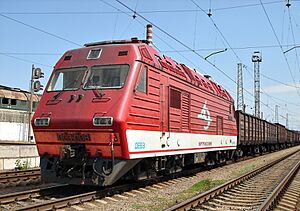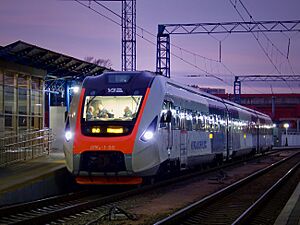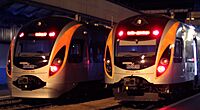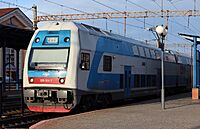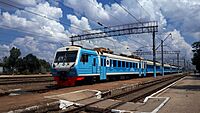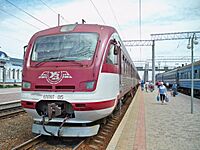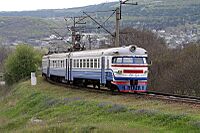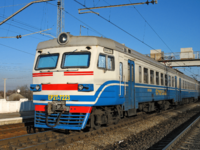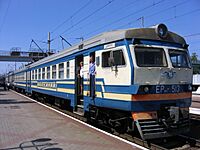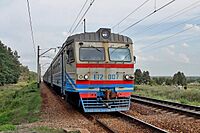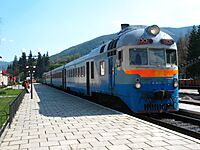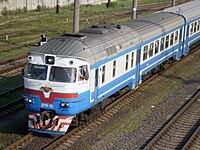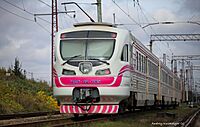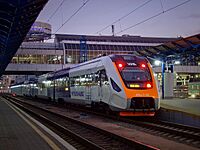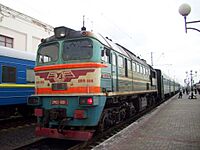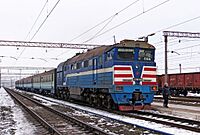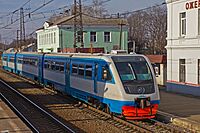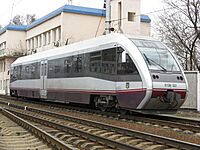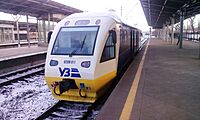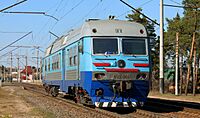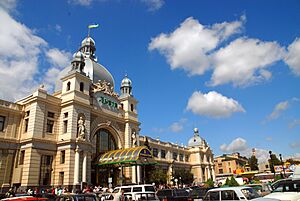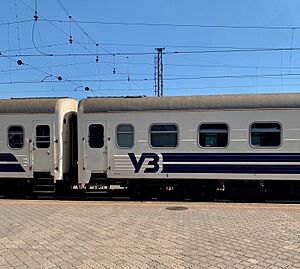Ukrainian Railways facts for kids
 |
|
| Public joint-stock company | |
| Industry | Railway transportation, Railway infrastructure, intermodal freight transport |
| Founded | 1991 |
| Headquarters | 5 Jerzy Giedroyc Street, Kyiv, Ukraine, 03680 |
|
Number of locations
|
1,700 stations and halts |
|
Area served
|
Ukraine |
|
Key people
|
Oleksandr Pertsovskyi (CEO) |
| Products | Rail transport services (passenger & cargo) |
| Revenue | |
| Owner | Government of Ukraine (100%) |
|
Number of employees
|
191,700 (2023) |
| Parent | Ministry of Infrastructure |
| Divisions | 6 branches (Kyiv, Donetsk, Lviv, Odesa, Kharkiv, Dnipro) |
Ukrzaliznytsia (pronounced "Ook-rah-zah-leez-NYT-syah") is Ukraine's national railway company. It is owned by the government and manages almost all train travel and railway lines in the country. Ukrzaliznytsia is one of the biggest railway companies in the world. It ranks sixth for carrying passengers and seventh for moving goods.
As of 2020, Ukraine's main railway network was about 19,787 kilometers long. This makes it the 13th largest railway network globally. Most of its tracks are "broad-gauge," which means they are wider than standard tracks. Ukraine is also building more "standard-gauge" tracks. This will help connect its railway system better with countries in the European Union.
In 2015, Ukrzaliznytsia changed from a government agency to a public company. It is still fully owned by the state. The company works under the Ministry of Infrastructure. It has six regional railway companies that manage all train services and maintenance. The company employs over 191,700 people across Ukraine.
During the 2022 conflict, Ukrzaliznytsia kept running trains. It helped millions of people leave cities and the country safely. Some railway links to Russia were destroyed to stop their use by the military. However, trains continued to operate within Ukraine and to neighboring countries. These included Poland, Hungary, Moldova, and Slovakia. An old railway line to Poland was quickly rebuilt. Other lines, previously only for cargo, were opened for passengers. The railway helped over two million people evacuate. When some Black Sea ports became unsafe for grain export, trains became a key way to send grain to Europe.
Contents
How Ukrzaliznytsia is Organized
Financial Overview
Ukrzaliznytsia is a very important company for Ukraine's economy. In 2017, it was one of the most profitable companies in the country. It earned about ₴74 billion (Ukrainian Hryvnia) that year.
How the Company is Managed
The railway system is divided into six regional companies. These are Donetsk, Lviv, Odesa, Southern, South-Western, and Cisdnieper. These divisions are mainly for management and do not always match the actual train lines. Their names come from old times, like the Russian and Austro-Hungarian Empires. For example, the 'South-Western Railway' actually covers the north-central part of Ukraine. The 'Southern Railway' operates in the east.
Each of these six regional railways has its own main office. These offices are in the following cities:
- Donetsk Railway – Lyman (This is a temporary office because Donetsk is not under Ukrainian control.)
- Lviv Railway – Lviv
- Odesa Railway – Odesa
- Southern Railway – Kharkiv
- Southwestern Railway – Kyiv
- Cisdnieper Railway – Dnipro
Since 2014, the Crimean Railways division is no longer managed by Ukraine. In February 2025, a Ukrainian government group suggested that the names "Southwestern" and "Southern Railways" should be changed. They said these names are linked to old imperial policies and go against a law about decolonization.
Changes and Improvements
Ukrzaliznytsia has faced some challenges from its past. The company is working on reforms to make its services better and more open.
New Railway Laws
A new law called "On Railway Transport of Ukraine" was created. This law helps Ukraine's railway rules match those in the European Union. It explains the duties of the railway operator, train companies, and track owners. It also sets rules for managing the railway system and for train safety. This law helps make train travel safer and allows for more competition in the railway market. Experts from Europe supported this law, seeing it as a key step for real changes in the industry.
Reorganizing Ukrzaliznytsia
The company is being reorganized into different parts. This means creating separate groups for freight (cargo), passengers, production, and infrastructure. This change helps make sure money flows are clear within the company. It also improves how each part of the business is managed. This reorganization prepares Ukrzaliznytsia for new private companies to join the railway market.
Trains and Equipment
Ukrzaliznytsia has several factories that can repair and build locomotives and train cars. There are also other factories in Ukraine, like Kryukiv Railcar Engineering Factory and Dnieper Railcar Engineering. These factories also build trains for Ukrzaliznytsia and other companies.
In 2010, Ukrzaliznytsia decided to buy 10 fast trains from Hyundai Rotem. These trains were called Inter City+ and started running in 2012. They connect major cities like Kyiv, Kharkiv, Donetsk, and Lviv. Later, they also connected to Dnipro and Odesa.
In 2017, Ukrzaliznytsia and GE Transportation started a partnership. They planned to update the train fleet over seven years. This included getting 30 new locomotives in 2018. About 40% of these were made in Ukraine.
Locomotives
| Image | Class | Type | Number | Manufacturer | Constructed | Notes |
|---|---|---|---|---|---|---|
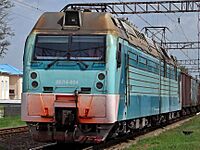 |
2EL4 | Electric locomotive | 6 | Luhanskteplovoz | 2009-2013 | |
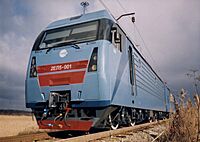 |
2EL5 | Electric locomotive | 20 | Luhanskteplovoz | 2005- | |
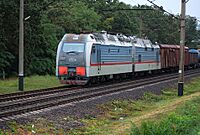 |
2ES5K | Electric locomotive | 15 | Novocherkassk Electric Locomotive Plant | 2004 | |
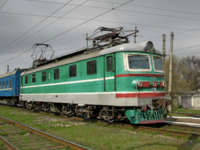 |
ChS2 | Electric locomotive | 111 | Škoda Works | 1958-1976 | |
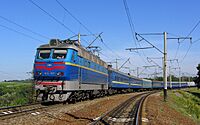 |
ChS4 | Electric locomotive | 150 | Škoda Works | 1963-1972 | |
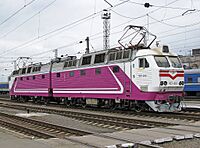 |
ChS7 | Electric locomotive | 27 | Škoda Works | 1983-1989 | |
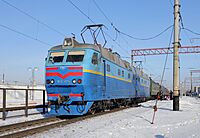 |
ChS8 | Electric locomotive | 36 | Škoda Works | 1983–89 | |
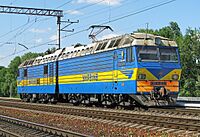 |
DE1 | Electric locomotive | 40 | NPO DEVZ | 1997–2008 | |
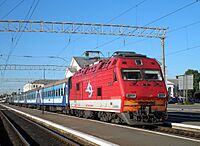 |
DS3 | Electric locomotive | 16 | GP NPK | 2003–08 | |
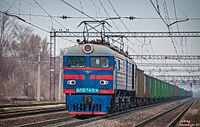 |
VL8 | Electric locomotive | ~200 | Novocherkassk Electric Locomotive Plant | 1953–67 | Some were damaged during the 2022 conflict. |
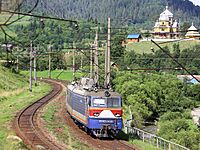 |
VL10 | Electric locomotive | ~240 | Novocherkassk Electric Locomotive Plant | 1961–1989 | |
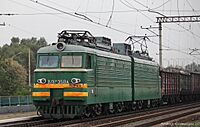 |
VL11 | Electric locomotive | 112 | Tbilisi electric locomotive builder plant | 1975-1978 | |
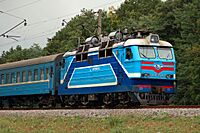 |
VL40U | Electric locomotive | 6 | Zaporizhzhia Electric Locomotive Plant | 2004 | |
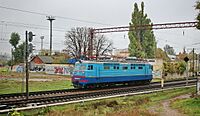 |
VL60 | Electric locomotive | Novocherkassk Electric Locomotive Plant | 1957-1967 | ||
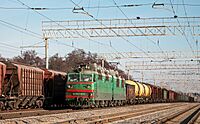 |
VL80 | Electric locomotive | Novocherkassk Electric Locomotive Plant | 1961-1995 | ||
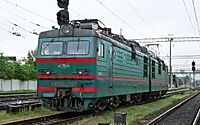 |
VL82 | Electric locomotive | Novocherkassk Electric Locomotive Plant | 1966-1979 | ||
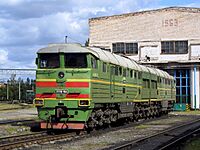 |
2TE116 | Diesel-electric locomotive | Luhanskteplovoz | 1971-2015 | ||
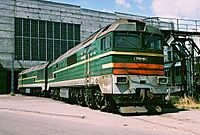 |
2ТЕ121 | Diesel-electric locomotive | 76 | Luhanskteplovoz | 1978-1992 | |
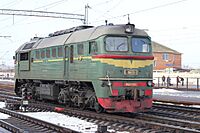 |
M62 | Diesel-electric locomotive | Luhanskteplovoz | 1965-1990 | ||
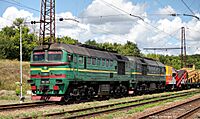 |
2M62 | Diesel-electric locomotive | Luhanskteplovoz | 1976-1990 | ||
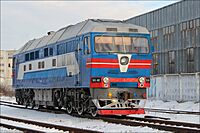 |
TEP70 | Diesel-electric locomotive | Kolomna Locomotive Works | 1973 | ||
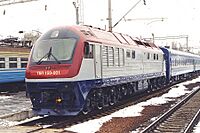 |
TEP150 | Diesel-electric locomotive | 4 | Luhanskteplovoz | 2005 | |
 |
TE33A | Diesel-electric locomotive | 70 | General Electric Transportation/JSC Lokomotiv | 2019- | |
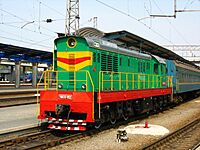 |
ChME3 | Diesel-electric shunting locomotive | ČKD | 1963-1994 | ||
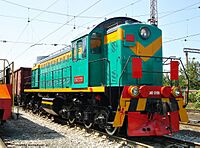 |
TEM2 | Diesel-electric shunting locomotive | Bryansk and Luhansk Locomotive Works | 1967–1987 | ||
 |
TEM18 | Diesel-electric shunting locomotive | Bryansk and Luhansk Locomotive Works | 1992- | ||
 |
TEM103 | Diesel-electric shunting locomotive | 1 | Electrotyazhmash | 2005 | |
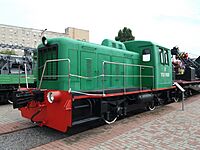 |
TGK2 | Diesel-hydraulic shunting locomotive | Kaluga Machine Building Plant | 1960-2008 | ||
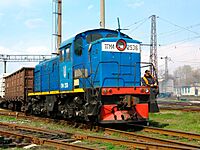 |
TGM4B | Diesel-hydraulic shunting locomotive | Lyudinovsky Locomotive Plant | 1971-1989 | ||
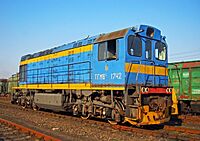 |
TGM6 | Diesel-hydraulic shunting locomotive | Lyudinovsky Diesel Locomotive Plant | 1966- | ||
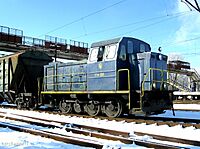 |
TGM23 | Diesel-hydraulic shunting locomotive | Murom Diesel Locomotive Plant | 1960- | ||
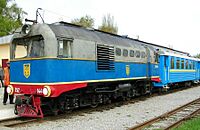 |
TU2 | Diesel-electric locomotive | 6 | Kaluga Machine Building Plant | 1955-1959 | Used on narrow gauge lines. |
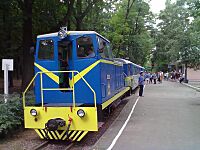 |
TU7 | Diesel-hydraulic locomotive | 1 | Kambarka Engineering Works | 1971 | Used on Antonivka narrow gauge line. |
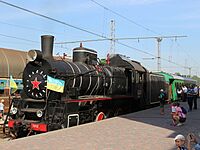 |
ER | Steam locomotive | 2 | Zegelsky Locomotive Works/Reșița Works | 1951 | Used for tourist trips. |
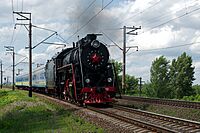 |
L | Steam locomotive | 1 | Luhanskteplovoz | 1953 | Used for tourist trips. |
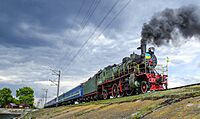 |
SU | Steam locomotive | 1 | Krasnoye Sormovo Factory | 1949 | Used for tourist trips. |
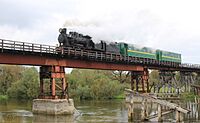 |
GR | Steam locomotive | 1 | Lokomotivbau Karl Marx Babelsberg | 1951 | Used for tourist services on Antonivka narrow gauge line. |
Passenger Trains and Railcars
Updating the Train Fleet
New Passenger Cars
In 2021, Ukrzaliznytsia planned to buy 100 new passenger cars. These cars were made by the Kryukiv Railway Car Building Works. Also in 2021, the company started using its first trains that are friendly for people with disabilities. These trains have special spaces for wheelchairs.
New Locomotives
In 2018, Ukrzaliznytsia bought 30 new diesel locomotives from General Electric. These were called TE33AC Trident. This was part of a bigger plan to work together for 15 years. The goal was to replace and update more of Ukraine's trains. However, later in 2020, the CEO of Ukrzaliznytsia said they would focus more on electric trains. Electric trains are more efficient.
In 2020, ₴400 million was set aside for urgent locomotive repairs. The Lviv Locomotive Repair Plant received an order to fix 6 electric locomotives. In 2021, Ukrzaliznytsia planned to spend ₴4.7 billion to repair its existing locomotives.
Alstom, a French company, is also interested in helping Ukrzaliznytsia get new locomotives. They might even build some of them in Ukraine. Ukrzaliznytsia is interested in buying 50 electric freight locomotives from Alstom. The French government might help pay for these.
Key Facts and Figures (2020)
- Main track length: 19,787 kilometers
- Electrified tracks (using electricity): 9,319 kilometers
- Number of train stations: 1,402
- Number of cargo wagons: 85,200
- Number of passenger cars: 3,883 (with 2,681 actively used)
- Number of locomotives: 1,944 (1,627 electric, 301 diesel)
- Average number of employees: 266,300 people
- Passengers carried (2019): 149.6 million
- Cargo transported (2019): 312.4 million tonnes
Types of Passenger Trains
In 2011, Ukrzaliznytsia created a new system to classify its passenger trains. This helps passengers understand the level of service and comfort they can expect. The system is based on the type of train and its carriages.
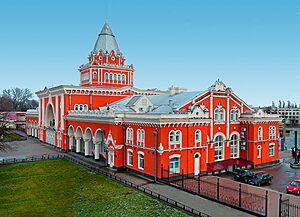
Here are the different classes of passenger trains:
- Daytime Passenger Trains:
* Euro City (EC) – These are fast trains (at least 90 km/h) for international travel. They offer very high comfort and service. They have first and standard classes. * Inter City+ (IC+) – These are also fast trains (at least 90 km/h) for travel within Ukraine. They offer very high comfort and service. They have first and standard classes. These trains are currently operated by Hyundai Rotem trains. They connect Kyiv with cities like Kharkiv, Lviv, Dnipro, and Odesa. There is also an international express train from Kyiv to Przemyśl in Poland. * Inter City (IC) – These trains travel at speeds between 70 km/h and 90 km/h within Ukraine. They offer a good level of service and comfort. They have first, standard, and economy classes. * Regional Express (РЕ) – These trains also travel between 70 km/h and 90 km/h within Ukraine. They offer a standard level of service and comfort. They have first, standard, and economy classes. * Regional train (РП) – These trains travel up to 70 km/h within Ukraine. They offer a standard level of service and comfort. They have standard and economy classes.
- Nighttime Passenger Trains:
* Euro Night (EN) – These are fast night trains (at least 90 km/h) for international travel. They offer very high comfort and service. They have sleeping cars with 2 or 4 berths (beds). * Night Express (НЕ) – These night trains travel between 70 km/h and 90 km/h for both international and domestic routes. They offer a good level of service and comfort. They have sleeping cars with 2 or 4 berths, and also "platskarta" (open-plan sleeping cars). * Night fast (НШ) – These night trains travel between 50 km/h and 70 km/h for international and domestic routes. They offer a good level of service and comfort. They have sleeping cars with 2 or 4 berths, and platskarta. * Night passenger (НП) – These night trains travel up to 50 km/h for international and domestic routes. They offer a good level of service and comfort. They have sleeping cars with 4 berths and platskarta.
This new classification system helps passengers easily understand what kind of train they are taking. It also matches the train classification used in the European Union.
Science and Education
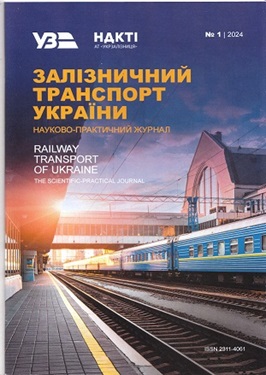 |
|
| Discipline | Railway engineering |
|---|---|
| Language | Original language |
| Edited by | Serhiy Vitaliyovych Myamlin |
| Publication details | |
| Publisher |
Rail Transport Scientific and Engineering Institute (branch of JSC Ukrzaliznytsia) (Ukraine)
|
|
Publication history
|
1996–present |
| Frequency | Quarterly |
|
Open access
|
Yes |
| Indexing | |
| ISSN | 2311-4061 |
| Links | |
|
|
Ukrzaliznytsia has its own research and development center called NDKTI. This institute studies and designs new technologies for railways. They work on things like railway lines, trains, safety, and communication systems. They also publish a quarterly magazine called Railway Transport of Ukraine. This magazine shares new ideas and research results with engineers and railway workers.
The National Railway University in Dnipro is a major educational center. It has 10 different departments, a technical school, and a business school. It also has branches in Odesa and Lviv. The university has 450 professors and offers 39 different study programs related to railway transport.
Leaders of Ukrzaliznytsia
Presidents and General Directors
- 1991–1993 Borys Oliynyk (President)
- 1993–1997 Leonid Zheleznyak (General Director)
- 1997–2000 Anatoliy Slobodyan
- 2000–2004 Heorhiy Kirpa
- 2005–2005 Volodymyr Korniyenko
- 2005–2005 Zenko Aftanaziv
- 2005–2006 Vasyl Hladkikh
- 2006–2007 Volodymyr Kozak
- 2007–2007 Petro Naumenko
- 2007–2008 Vasyl Melnychuk
- 2008–2011 Mykhailo Kostiuk
- 2011–2012 Volodymyr Kozak
- 2013–2014 Serhiy Bolobolin
- 2014–2014 Borys Ostapyuk
- 2014–2015 Maksym Blank (acting)
- 2015–2015 Oleksandr Zavhorodniy (acting)
Board Directors
- 2015–2016 Oleksandr Zavhorodniy (acting)
- 2016–2016 Yevhen Kravtsov (acting)
- 2016–2016 Vitaliy Zhurakovskyi (acting)
- 2016–2017 Wojciech Balczun
- 2017–2020 Yevhen Kravtsov (acting)
- 2020 Marček Zhelko (acting)
- 2020 Ivan Yuryk (acting)
- 2020–2021 Volodymyr Zhmak
- 2021–2023 Oleksandr Kamyshin
- 2023–November 2024 Yevhen Liashchenko
- Yuzef Leonidovych Tuley (Representative, acting until March 31, 2025)
See also
 In Spanish: Ukrzaliznytsia para niños
In Spanish: Ukrzaliznytsia para niños
- Rail transport in Ukraine
- Transport in Ukraine
- Railway electrification system


